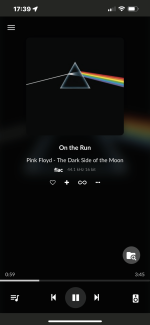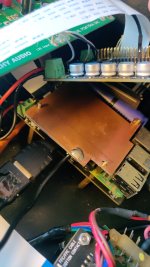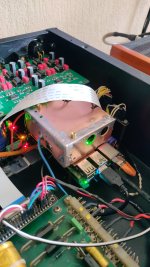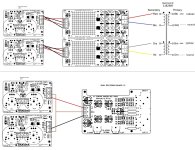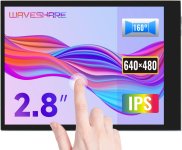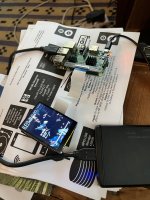@Drive Shaft
Yes, it's true. If you run a phase noise analyzer, you will understand how much phase noise can be introduced by the vibration, temperature and EMI noise .
.
So, those steps really work.
Ian
Yes, it's true. If you run a phase noise analyzer, you will understand how much phase noise can be introduced by the vibration, temperature and EMI noise
So, those steps really work.
Ian
Hi @iancanada quick question and I'd appreciate your help. I mistakenly bought this board and it looks like it only supports DSD64 via DOP and the max resolution for PCM is 24/192. Is there another HAT i can add to expand its capabilities to support playback all the way up to DSD256/512 natively and/or PCM 768khz over I2S? I'm hoping to keep this and expand rather than having to resell or return. Please let me know!
@Drive Shaft
Yes, it's true. If you run a phase noise analyzer, you will understand how much phase noise can be introduced by the vibration, temperature and EMI noise.
So, those steps really work.
Ian
Since you publicly stated, I have more confidence to pursue more anti-vibration solutions. The 3M EMI suppression sheets seem interesting too.
I was very lucky Andrea soldered my Crystal to the PCB as the wires are super thin due to vibration issues, so I have full confidence in my external clock. If I had to do the soldering myself, the confidence would be much lower because I have never worked with that thin of cable. It's very, very rare that Andrea would solder the Crystal for anyone as it kind of goes against the DIY-spirit. I believe the cable is very thin as it's more resilient to vibration. By sort of floating in mid-air, the thin cable is less susceptible to vibration.
So my job is easy, I just have to fine tune by pro actively tackling vibration and eventually giving it UcPure/UcBalancer power.
Thanks for giving me the confidence I'm taking steps in the right direction regarding pro-actively tackling vibration and that it's not all for naught.
Last edited:
I'm sorry there is no way to upgrade that board. And, BTW, that board doesn't really re-clock music signals by audio clocks.Hi @iancanada quick question and I'd appreciate your help. I mistakenly bought this board and it looks like it only supports DSD64 via DOP and the max resolution for PCM is 24/192. Is there another HAT i can add to expand its capabilities to support playback all the way up to DSD256/512 natively and/or PCM 768khz over I2S? I'm hoping to keep this and expand rather than having to resell or return. Please let me know!
To achieve music re-clock for DSD256 or higher, the only solution so far is FifoPiQ7+HdmiPiPro through USB(with StationPiPro, the coming ReceiverPi DDC or the BridgePi).
Ian
New build. Thanks to @iancanada for the great hardware and advice and @Gabster 2000 for some of his videos.
0. Spike Mounts until i figure a nice home to put in. Looks like a Lunar Lander!
1. PurePi
2. RPi3B | USB Flac Drive w Volume
3. ShieldPi Pro
4. FiFoPiQ7
5. MonitorPi Pro
6. TransPortPiAES | Coax PCM out
7. DACMagic200M Coax PCM in
Blown away by the clarity, transparency, sound stage and lush fullness of this thing.
Makes my Cambridge DAC Magic 200M sound like it should through the coax input streaming the IAN Pi Stack through it.
The Cambridge DAC bluetooth input is Shite compared to this - thin and fragile - same with the USB input.
I’m playing off FLAC on PiUSB and via Apple Airplay CD Audio quality - both fantastic. I actually can't tell them apart aside from the odd AirPlay dropout due to my Wifi. Now to put iFi wifi filters on my gear.
Revealing more source than I've ever heard in a 16b44.1 file before. Like listening to a CD for the first time in 1980.
Jitter? What Jitter?
Gonna build a DAC pre-amp next.
Cheers
John

0. Spike Mounts until i figure a nice home to put in. Looks like a Lunar Lander!
1. PurePi
2. RPi3B | USB Flac Drive w Volume
3. ShieldPi Pro
4. FiFoPiQ7
5. MonitorPi Pro
6. TransPortPiAES | Coax PCM out
7. DACMagic200M Coax PCM in
Blown away by the clarity, transparency, sound stage and lush fullness of this thing.
Makes my Cambridge DAC Magic 200M sound like it should through the coax input streaming the IAN Pi Stack through it.
The Cambridge DAC bluetooth input is Shite compared to this - thin and fragile - same with the USB input.
I’m playing off FLAC on PiUSB and via Apple Airplay CD Audio quality - both fantastic. I actually can't tell them apart aside from the odd AirPlay dropout due to my Wifi. Now to put iFi wifi filters on my gear.
Revealing more source than I've ever heard in a 16b44.1 file before. Like listening to a CD for the first time in 1980.
Jitter? What Jitter?
Gonna build a DAC pre-amp next.
Cheers
John
Attachments
Last edited:
@iancanada thank you for the quick response. I thought as much. Bummer.
Quick clarification, along with FifoPiQ7+HdmiPiPro, do i just need either one of these 3 - Stationpipro, ReceivePi DDC or Bridge Pi?
Quick clarification, along with FifoPiQ7+HdmiPiPro, do i just need either one of these 3 - Stationpipro, ReceivePi DDC or Bridge Pi?
made a copper shield based on video gabster.
shield for the pi I think I hear a little less noise, the FiPiMA also shielded but no improvement here.
Understanding Shielding with a Raspberry Pi in a HIFI Dac. How to Measure noise with (simple tools)
shield for the pi I think I hear a little less noise, the FiPiMA also shielded but no improvement here.
later i saw that ian canada has a shield pro that does the same.
https://www.audiophonics.fr/en/powe...r-supply-filter-for-raspberry-pi-p-16965.html
next upgrade is a UcPureMkII.
shield for the pi I think I hear a little less noise, the FiPiMA also shielded but no improvement here.
Understanding Shielding with a Raspberry Pi in a HIFI Dac. How to Measure noise with (simple tools)
shield for the pi I think I hear a little less noise, the FiPiMA also shielded but no improvement here.
later i saw that ian canada has a shield pro that does the same.
https://www.audiophonics.fr/en/powe...r-supply-filter-for-raspberry-pi-p-16965.html
next upgrade is a UcPureMkII.
Attachments
I wish someone can come up with a shielded thin and flexable giop extension cable. I tried monitor pi today and I need to figure out how to shield the cable and monitor pi itself from the rest of the stack. I lost some sweetness in the highs, so much so I have to take the monitor pi off the stack.
To get a better idea how to plan for the upcoming ReceiverPi DDC, you just need to browse the StationPi Pro manual with a keen eye:

On the Audio side, you have your re-clocking and output board. On the RPi side, at the very bottom is a Receiver Pi Pro. It's very difficult to distinguish from other Ian boards unless you are specially looking for that use case. So it's very easy to overlook that it is even there. There, you have inputs not outputs for Toslink and HDMI LVDS. I'm not familiar with the RCA/Coax input. The upcoming ReceiverPi DDC may have USB input, who knows?
So remove the RPi out of the equation, you can feed Toslink from your CD player or LVDS from a i2s bridge PCI-E card in theory or maybe in the future USB? You can physically remove the RPi from the StationPi Pro.
This gives me the possibility of running an Industrial Intel Motherboard via UcPure/LiFePO4 power supply and a i2s bridge PCI-E card. Or maybe HDMI out from an Nvidia PCI-E card? I don't know as I'm not familiar with LVDS/i2S extraction from HDMI as it's too cutting edge. But for example, on AppleTV you can extract Toslink from HDMI. That's how AppleTV users get Toslink into their Home Theatre systems.

+

I believe you don't need a StationPi Pro either and just run the ReceiverPi DDC in your stack. I haven't thought this through yet as I'm years away from life without an RPi. The RPi has treated me great so not sure if this is what I want but flexibility of options is always great to have.
Anyways, I won't be ready for any of this for a few years but look forward to how the ReceiverPi product line evolves. I'm hoping for USB without USB clocking and just feed non-clocked USB straight into the Q7 or by some miracle get HDMI LVDS to input Q7 from just a normal HDMI Output. Again, I don't know how that tech works or if it's even possible but it will be interesting how it evolves. Currently, you need clocks on the third-party USB board and I'm too happy with my native setup to change things up. But I definitely would like to scale to an Intel i9+ and utilise Apacer Audiophile RAM for my source at the CPU-level in the long run.
I'm currently using PCI-E USB (AsMedia ASM3142 USB chipset) for Gaming with a USB DAC and can never go back to Non-PCI-E.
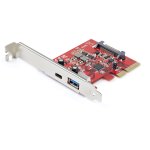
So USB PCI-E or HDMI PCI-E or i2S bridge PCI-E into a Q7 for re-clocking I would consider moving on from the RPi. Of course, it would have to be off Mains so passively powered.
On the Audio side, you have your re-clocking and output board. On the RPi side, at the very bottom is a Receiver Pi Pro. It's very difficult to distinguish from other Ian boards unless you are specially looking for that use case. So it's very easy to overlook that it is even there. There, you have inputs not outputs for Toslink and HDMI LVDS. I'm not familiar with the RCA/Coax input. The upcoming ReceiverPi DDC may have USB input, who knows?
So remove the RPi out of the equation, you can feed Toslink from your CD player or LVDS from a i2s bridge PCI-E card in theory or maybe in the future USB? You can physically remove the RPi from the StationPi Pro.
This gives me the possibility of running an Industrial Intel Motherboard via UcPure/LiFePO4 power supply and a i2s bridge PCI-E card. Or maybe HDMI out from an Nvidia PCI-E card? I don't know as I'm not familiar with LVDS/i2S extraction from HDMI as it's too cutting edge. But for example, on AppleTV you can extract Toslink from HDMI. That's how AppleTV users get Toslink into their Home Theatre systems.
+
I believe you don't need a StationPi Pro either and just run the ReceiverPi DDC in your stack. I haven't thought this through yet as I'm years away from life without an RPi. The RPi has treated me great so not sure if this is what I want but flexibility of options is always great to have.
Anyways, I won't be ready for any of this for a few years but look forward to how the ReceiverPi product line evolves. I'm hoping for USB without USB clocking and just feed non-clocked USB straight into the Q7 or by some miracle get HDMI LVDS to input Q7 from just a normal HDMI Output. Again, I don't know how that tech works or if it's even possible but it will be interesting how it evolves. Currently, you need clocks on the third-party USB board and I'm too happy with my native setup to change things up. But I definitely would like to scale to an Intel i9+ and utilise Apacer Audiophile RAM for my source at the CPU-level in the long run.
I'm currently using PCI-E USB (AsMedia ASM3142 USB chipset) for Gaming with a USB DAC and can never go back to Non-PCI-E.

So USB PCI-E or HDMI PCI-E or i2S bridge PCI-E into a Q7 for re-clocking I would consider moving on from the RPi. Of course, it would have to be off Mains so passively powered.
@Drive Shaft
Thanks for your input! I came to this thread thinking that these components offered by Ian could take me to a higher level in reproducing digital to analog! I built my audio system years ago and the gear I have I invested quite a bit of hard earned money for! That being said, I was looking to build a unit that I could use specifically for the cables (RCA interconnects/USB cable/coaxial digital cable) that would connect to an input side of one of the pcb's that Ian offers! At this point I'm wondering if I could achieve that next level or more from building a DAC using the components that Ian talks about over the audio gear I already own?
So it is my understanding, that in order for me to build this DAC unit, the components I would need would be a ReceiverPi DDC, FifoPi Q7, DAC hat, MonitorPi Pro, and a good PS. My understanding of these components are kind of noobish, so I am really just learning on how all these components will work together!
I'm not sure as to the other connections/connectors that could make enough difference in transferring the digital signal better than the USB cable and the coaxial cable I use now? I understand that the cables used for connecting all of the audio components in a system can make some noticeable differences, but again I believe that it is dependent upon the capacitance, inductance, etc. of the cables vs the system, and also personal preference! I use to believe that how in the world can a cable, example USB, could make a difference in sound. Well my mind was changed when I started comparing quite a few different brands of USB cables. I finally settled on the Wire World Platinum USB cable.
@iancanada
Can you please check your PM? Thanks
Thanks for your input! I came to this thread thinking that these components offered by Ian could take me to a higher level in reproducing digital to analog! I built my audio system years ago and the gear I have I invested quite a bit of hard earned money for! That being said, I was looking to build a unit that I could use specifically for the cables (RCA interconnects/USB cable/coaxial digital cable) that would connect to an input side of one of the pcb's that Ian offers! At this point I'm wondering if I could achieve that next level or more from building a DAC using the components that Ian talks about over the audio gear I already own?
So it is my understanding, that in order for me to build this DAC unit, the components I would need would be a ReceiverPi DDC, FifoPi Q7, DAC hat, MonitorPi Pro, and a good PS. My understanding of these components are kind of noobish, so I am really just learning on how all these components will work together!
I'm not sure as to the other connections/connectors that could make enough difference in transferring the digital signal better than the USB cable and the coaxial cable I use now? I understand that the cables used for connecting all of the audio components in a system can make some noticeable differences, but again I believe that it is dependent upon the capacitance, inductance, etc. of the cables vs the system, and also personal preference! I use to believe that how in the world can a cable, example USB, could make a difference in sound. Well my mind was changed when I started comparing quite a few different brands of USB cables. I finally settled on the Wire World Platinum USB cable.
@iancanada
Can you please check your PM? Thanks
Hi @iancanada,
Since I'm rusty at this hobby, it takes me a while to digest so after the above post I realise I'm going to lose my 16-bitness and isolation.
With a USB optical cable, I'll retain isolation but lose 16-bitness.
Pure 16-bit is really important to I as I value my Well-Mastered CDs >>>> Hardware. High Quality CDs are worth more in value, well-mastered quality and sentimentality than any High Resolution or Gimmick Resolution or Hardware out there can ever acheive.
So being able to retain Pure 16-bit is a dealbreaker.
So question:

I think it's optimal for I to go back to a StationPi SMT. The StationPi Pro I will not need the expandability unless PCI-E Toslink to ReceiverPi retains 16-bit.
I think my best hope is for a RPi5 w/ 16GB RAM which is a few years away.
I don't think going to an Intel CPU is worth it anymore as my rare Well-Mastered CDs >>>> Hardware. Only if I want 32-bit+ Resolution then it's worth pursuing. So in my use case, I value 16-bit CD Mastering more than the hardware so I have to build around 16-bit CD Mastering not build around the Hardware.
So for example when I'm not running the finest Audiophile Gold CD Masterings or Masterings before Sound Processing was implemented, I run Japanese Presssings which have zero to low noise floor.

Slow shipping from Japan to USA is only about $12 for four CDs. That's why I love Free Trade Agreements.
So with Andrea's clock, I really look throughout the world for the best Masterings because it's worth it when your chain is completely transparent @ 5.6448 MHz. Sometimes, it Gold CD, sometimes it's Japanese Pressing, sometimes Dutch. Bread and butter are West German and Japan Presssings before late 80's as they are absolutely Euphoric with State of The Art Clocks.
An example of a West German Pressing (read bottom print on CD) and before Sound Processing was implemented:

Absolutely Euphoric @ 5.6448 MHz and Pure 16-bit. I can never move away from Pure 16-bit.
Since I'm rusty at this hobby, it takes me a while to digest so after the above post I realise I'm going to lose my 16-bitness and isolation.
With a USB optical cable, I'll retain isolation but lose 16-bitness.
Pure 16-bit is really important to I as I value my Well-Mastered CDs >>>> Hardware. High Quality CDs are worth more in value, well-mastered quality and sentimentality than any High Resolution or Gimmick Resolution or Hardware out there can ever acheive.
So being able to retain Pure 16-bit is a dealbreaker.
So question:
If I use a PCI-E Soundcard with Toslink OUT, would it retain it's 16-bitness? I understand you mentioned the quality will be there due to the Q7 re-clocking the Toslink input but what about Pure 16-bit? You mentioned if you want isolation, this is the way to go.
I think it's optimal for I to go back to a StationPi SMT. The StationPi Pro I will not need the expandability unless PCI-E Toslink to ReceiverPi retains 16-bit.
I think my best hope is for a RPi5 w/ 16GB RAM which is a few years away.
I don't think going to an Intel CPU is worth it anymore as my rare Well-Mastered CDs >>>> Hardware. Only if I want 32-bit+ Resolution then it's worth pursuing. So in my use case, I value 16-bit CD Mastering more than the hardware so I have to build around 16-bit CD Mastering not build around the Hardware.
Input to ReceiverPi | ? |
PCI-E i2s bridge | HDMI cables use traditional wiring which absolutely do not isolate. No thanks. |
PCI-E HDMI LVDS | HDMI cables use traditional wiring which absolutely do not isolate. No thanks. |
PCI-E USB | USB optical works for isolation, but lose Pure 16-bit. No thanks. |
PCI-E Toslink Soundcard | 16-bit? |
So for example when I'm not running the finest Audiophile Gold CD Masterings or Masterings before Sound Processing was implemented, I run Japanese Presssings which have zero to low noise floor.
Slow shipping from Japan to USA is only about $12 for four CDs. That's why I love Free Trade Agreements.
So with Andrea's clock, I really look throughout the world for the best Masterings because it's worth it when your chain is completely transparent @ 5.6448 MHz. Sometimes, it Gold CD, sometimes it's Japanese Pressing, sometimes Dutch. Bread and butter are West German and Japan Presssings before late 80's as they are absolutely Euphoric with State of The Art Clocks.
An example of a West German Pressing (read bottom print on CD) and before Sound Processing was implemented:
Absolutely Euphoric @ 5.6448 MHz and Pure 16-bit. I can never move away from Pure 16-bit.
Last edited:
Hello; I have a question about the 2x 5V (1x-5/1x+5)power supply of the OPA861 fully Balanced Zero Feedback I/V Stage.
1. could I use 2x UcPi board with 2x UCCONDITIONER 5V ?
https://www.audiophonics.fr/en/powe...er-supply-board-for-raspberry-pi-p-16717.html
2. or would 2x LIFEPO4 MINI 6.6 V with 2x UCCONDITIONER 5V also work?
https://www.audiophonics.fr/en/batt...-battery-power-supply-module-66v-p-15832.html
I would like to connect it like this, only without the toroidal transformer and Linear Pi Dual..
1. could I use 2x UcPi board with 2x UCCONDITIONER 5V ?
https://www.audiophonics.fr/en/powe...er-supply-board-for-raspberry-pi-p-16717.html
2. or would 2x LIFEPO4 MINI 6.6 V with 2x UCCONDITIONER 5V also work?
https://www.audiophonics.fr/en/batt...-battery-power-supply-module-66v-p-15832.html
I would like to connect it like this, only without the toroidal transformer and Linear Pi Dual..
Attachments
Hi, Does anybody know if this screen works with Ian Pi Audio stacks?
https://www.waveshare.com/wiki/2.8inch_DPI_LCD?amazon
I'm running Pi, USB SSD drive, Ian streaming stack (shield pro, fifopiQ7, monitor pi pro, TransportAES, volumio
https://www.waveshare.com/wiki/2.8inch_DPI_LCD?amazon
I'm running Pi, USB SSD drive, Ian streaming stack (shield pro, fifopiQ7, monitor pi pro, TransportAES, volumio
Attachments
Hi, Does anybody know if this screen works with Ian Pi Audio stacks?
https://www.waveshare.com/wiki/2.8inch_DPI_LCD?amazon
I'm running Pi, USB SSD drive, Ian streaming stack (shield pro, fifopiQ7, monitor pi pro, TransportAES, volumio
Note, it works with volumIO and a bare RPi3B with ian GPIO extender kit no other hats for sure. See picture. I just don't want to blow anything up but adding the audio boards. This is a 5V2.5A iFi power supply. The screen seems to say you need a 3A PS, but so far it works with just RPi3B and VolumIO and USB SSD.
excerpt from above site on pinouts below. It looks like the pinout for RGB uses some of the same pins as i2S, so i don't think they will work together.
If this is too off topic from the audio board stuff, let me know. I have built the streamer and now just want a kiosk display running and have chosen this little DPI LCD screen which goes on the 40 PIN GPIO.
Interface
- The pin of "NC" means that the touch screen does not occupy this pin, and the user can use it for other applications.
| PIN NO. | SYMBOL | DESCRIPTION |
|---|---|---|
| 1 | NC | Not connected |
| 2 | 5V | 5V power |
| 3 | VSYNC | Vertical synchronization |
| 4 | 5V | 5V power |
| 5 | HSYNC | Horizontal synchronization |
| 6 | GND | Ground |
| 7 | B2 | RGB signal lines |
| 8 | G4 | RGB signal lines |
| 9 | GND | Ground |
| 10 | G5 | RGB signal lines |
| 11 | G7 | RGB signal lines |
| 12 | PWM | Backlight control (Pi4 can only turn on/off the backlight. Only the earlier versions support brightness adjustment with PWM) |
| 13 | TP_INT | Interrupt pin of touch panel |
| 14 | GND | Ground |
| 15 | R4 | RGB signal lines |
| 16 | R5 | RGB signal lines |
| 17 | NC | Not connected |
| 18 | R6 | RGB signal lines |
| 19 | TP_SDA | The I2C SDA of touch panel |
| 20 | GND | Ground |
| 21 | B7 | RGB signal lines |
| 22 | R7 | RGB signal lines |
| 23 | TP_SCL | The I2C SCL of touch panel |
| 24 | B6 | RGB signal lines |
| 25 | GND | Ground |
| 26 | B5 | RGB signal lines |
| 27 | LCD_CLK | Clock pin of LCD panel |
| 28 | DE | Data enable of LCD panel |
| 29 | B3 | RGB signal lines |
| 30 | GND | Ground |
| 31 | B4 | RGB signal lines |
| 32 | G2 | RGB signal lines |
| 33 | G3 | RGB signal lines |
| 34 | GND | Ground |
| 35 | NC | Not connected |
| 36 | G6 | RGB signal lines |
| 37 | NC | Not connected |
| 38 | R2 | RGB signal lines |
| 39 | GND | Ground |
| 40 | R3 | RGB signal lines |
Attachments
Thanks for the update Ian. I'm okay because by posting about the upcoming ReceiverPi DDC, it forced me to get back to the basics.
No hurry for answers on my part because I'm a few years away from alternative solutions. So I'll ask again in a few years, you can ignore my question.
I'm just going to bear down and focus on the StationPi SMT (No Bells and Whistles) along with the TransportPiAES for the best Toslink Chain possible.

Your comparision chart really pushed me over the edge for a possible TransportPiAES. Not because it has AES functionality, but because it's the Flagship S/PDIF transport with the highest performance. I don't want to ruin my FPGA DAC ARC, so I'm hoping to justify for GB2023.



I believe I bought the TransportPi MKII this year so I didn't need a doubler anymore, so it takes a lot to justify on my side but my chain is so tight the TransportPiAES S/PDIF flagship would always be in the back of my mind. Because I have no leaks, the TransportPi MKII may be consider a leak even though it's completely new. No worries, The TransportPi MKII will go towards my Redundant system as I plan to order another 5.6448 MHz clock in 2024-2025. I wish I never stumbled upon TransportPiAES as a Flagship S/PDIF transport. I was quite content for it to be a AES option. But once I realise it's an S/PDIF upgrade, I don't think I can resist. Especially since no one focuses on improving S/PDIF anymore for at least the last decade so I think I can justify.
No hurry for answers on my part because I'm a few years away from alternative solutions. So I'll ask again in a few years, you can ignore my question.
I'm just going to bear down and focus on the StationPi SMT (No Bells and Whistles) along with the TransportPiAES for the best Toslink Chain possible.
Your comparision chart really pushed me over the edge for a possible TransportPiAES. Not because it has AES functionality, but because it's the Flagship S/PDIF transport with the highest performance. I don't want to ruin my FPGA DAC ARC, so I'm hoping to justify for GB2023.
I believe I bought the TransportPi MKII this year so I didn't need a doubler anymore, so it takes a lot to justify on my side but my chain is so tight the TransportPiAES S/PDIF flagship would always be in the back of my mind. Because I have no leaks, the TransportPi MKII may be consider a leak even though it's completely new. No worries, The TransportPi MKII will go towards my Redundant system as I plan to order another 5.6448 MHz clock in 2024-2025. I wish I never stumbled upon TransportPiAES as a Flagship S/PDIF transport. I was quite content for it to be a AES option. But once I realise it's an S/PDIF upgrade, I don't think I can resist. Especially since no one focuses on improving S/PDIF anymore for at least the last decade so I think I can justify.
Last edited:
@Drive Shaft
Thanks for your input! I came to this thread thinking that these components offered by Ian could take me to a higher level in reproducing digital to analog! I built my audio system years ago and the gear I have I invested quite a bit of hard earned money for! That being said, I was looking to build a unit that I could use specifically for the cables (RCA interconnects/USB cable/coaxial digital cable) that would connect to an input side of one of the pcb's that Ian offers! At this point I'm wondering if I could achieve that next level or more from building a DAC using the components that Ian talks about over the audio gear I already own?
For I, it's not always about reproducing D/A. Sometimes, it's about subtlety. I want zero to super low noise floor. I want optical isolation from ground loops and airbourne COVID (EMI/RFI). If I can't get optical isolation, I go for solid core isolation as a last resort for USB cables. For power, solid core isolation is standard.
So I don't mind investing in passive power supplies as I can always re-purpose if things don't work out with my current rig. 5V and 12V are pretty industry standard so safe to invest while 3.3V and 15.5V are for more specific use cases.
So UcPure/UcBalancer are a very safe investment. The Eaton UltraCaps life expectancy is around 20 years. Having a foundation of zero to super low noise floor is a must for I, then I can build on top of that.
But for DACs, I'm of zero help. I have zero interest in OEM DACs. I exclusively only use British made Xilinx FPGA DACs.
I also have a very nichey use case. In my younger years, I ran B&Ws that is probably why I stick to British Hi-Fi. But later on I only stick to proprietary gear used and endorsed by sound professionals/artists in the Southern California Sound Industry.

So my use case is complex, but with Ian's gear it helps with a separation of duties not as an AIO (All-In-One) bundle:
- Ian Passive Power Supplies
- My Own Gear (USB Optical Cable, etc.)
- Ian Toslink with State of the Art Clocks. Possibly the best Toslink chain possible given everything is USB these days and it's powered by Ultra Capacitors.
- My Own Gear (FPGA DAC, etc.).
- My Own Southern California Sound Industry Professional Reference Gear
I have the best of all worlds with a separation of duties. Since UcPure/UcBalancer can be arguably world's best power supply, I have that covered for passive power. Since Ian's Stack with Andrea's State of the Art Clock can be arguably the world's best S/PDIF chain, I have that covered for Toslink to feed my FPGA DAC. No amount of money can fetch an Commercial equivalent as everything is focused on USB these days.
So I'm getting really good price-performance out of Ian's gear. For AIO Ian Stack, I have no clue how to extract the max value for OEM DACs.
With that said, my FPGA DAC also has an internal PLL Clock close to the DAC. So for modern use, it is considered best practice to architect your chain to utilise the Internal PLL CLock. I'm not ready to go there yet as my use case is maximise 16-bit CD-quality with State of the Art Clocks via 16-bit Toslink.
So for example, 95% of dCS users purchase a external clock along with their DAC even though their DAC already has a internal clock. I'm in this camp for now running an external clock, but things can change and I can go back to running the internal clock close to the DAC which a considered a modern best practice. But I'm happy to have both options. One for 16-bit Redbook and another one day for streaming.
So maybe in a few years if I stream I may build a Passively Powered Intel PCI-E USB optical rig:
UcPure/UcBalancer
Industrial Motherboard with a PCI-E Slot
PCI-E USB (ASM3142 chipset)
USB optical cable powered by UcPure/UcBalancer 5V
Low Latency Realtime Audiophile OS
FPGA DAC
So I will still need Ian's passive power supplies if I go this route.
I power my USB optical with UcPure/UcBalancer @5V, so that's staying put for the next decade.
So if your happy with your current DAC, make subtle improvements like Ian's Passive Power Supplies. Maybe an USB optical cable to pair with your Wire World Platinum USB cable? On this site, veteran Audiophile romaz mentions pairing a USB optical cable along with a Sablon $700 USB cable sounds better than the Sablon itself? So that is where subtlety takes into effect. Maybe by lowering the noise floor with optical isolation gives the Sablon USB more room to shine?
Romaz mentions the USB optical at this post near the bottom when discussing a $40,000 Music Streamer:
USB optical
So here is where romaz mentions pairing a USB cable with a USB optical cable:
That's right, Geoff. SlimRun optical + "any USB cable" I have tried sounds better than that USB cable alone with the Extreme.
pair
For I, the Ian Stack runs independently of the DAC so you can keep your options with third-party DACs open.
My reason for Toslink was optical isolation. USB did not provide optical isolation until a later point. I do enjoy my USB optical powered by UcPure 5V, but with State of the Art Clocks I need a few more years before experimenting with USB optical for Music again. For now, it's just for General Use and Gaming.
For I, it's a worthy investment as it's impossible to find alternative passive power options along with Toslink being phased-out. No one gives Toslink it's respect anymore like Ian so it's the perfect time to build a UltraCap powered Toslink chain. Because as we learned from COVID, supply chains disappear overnight so the opportunity maybe gone a few years from now.
But for a more straightforward OEM DAC rig, I never thought how I would approach that use case. It would help a little more to know how your current rig is configured. I'm guessing PC -> Wire World USB -> USB DAC? And you are trying to next level that? You are trying to feed PC -> Ian DDC? I think you only get to next level with upgraded clocks, passive power supplies, optical isolation or DACs.
For I, I definitely next leveled with State of the Art Clocks. For Average Clocks, it was nice but I can't say next level. I would probably moved on to USB optical if I had to choose between Average Clocks and the PLL clock on my FPGA DAC as it's considered "Best Practice". So I'm only staying put as it's Pure 16-bit with State of the Art Clocks + Isolation. Otherwise, I would have to do serious re-evaluation.
Also, streaming is not there as the Masterings are so Generic. Streaming services also manipulate the quality which I don't trust, so I doubt I will ever go full on USB optical for Music. And when streaming services get more greedy, quality will get worse. I'm just glad to have pristine State of the Art Toslink with pristine Rare Masterings. If I can justify for convenience, then big maybe but since I'm a Purist I really don't think I will every go USB optical for Music.
But for my next Summer Project, I'm hoping to build Solid Core USB DATA cables and see how that goes.
Last edited:
Hi Ian,
For Streamer build with TransportPi Digi card, will these list of items combination support and work? Please advise corrections if any.
Few more clarification questions to respond please....
Thanks in advance.
For Streamer build with TransportPi Digi card, will these list of items combination support and work? Please advise corrections if any.
26A : UcConditionerMkII 3.3V
MonitorPi PRO
20B : TransportPi Digi
23B : ShieldPi Pro multi-functional EMI shield/power filter
Rasberry Pi
48A : PurePi 5V + 3.3V ultracapacitor/LifePO4 battery power supply combo
Few more clarification questions to respond please....
- Cost of MonitorPi PRO
- By when we can expect SC-Pure clocks
- With TransportPi Digi plan
- UcConditionerMkII 3.3V recommended with this?
- “ ShieldPi Pro” or “ShieldPi Pro Mk ll “ which one best fits and recommended.
- If I play DSD file through Digi and my DAC is also not having DSD support - How this will be handled.
- With Fifo Q7 + TransportPiAES plan
- “ ShieldPi Pro” or “ShieldPi Pro Mk ll “ which one best fits and recommended.
- With Fifo Q7 + HDMIPro + TransportPiAES (Looking for Coaxial+I2S)
- How much you advise this combination and will there be any negative impact because of dual card addition to setup.
- Will TransportPi Digi (which got Coaxial+I2S in single card) compete with above combination - particularly when we see dual card distortions vs single card....
Thanks in advance.
- Home
- Source & Line
- Digital Line Level
- Asynchronous I2S FIFO project, an ultimate weapon to fight the jitter
